Synthesis, Characterization and Spectral Study of Zinc Complex with Gliclazide( N-(hexahydrocyclopenta[c]pyrrol-2(1H)-ylcarbamoyl)-4- methylbenzenesulfonamide) and its Hypoglycemic Activity
Bal Krishan*1 and Ishaq Zaafarany2
1Department of Chemistry, Gyan Ganga Institute of Technology & Management, Bhopal-462001(India) 2Department of Chemistry, Umm-Al-Qura University, Makkah Al Mukaramah, Saudi Arabia
DOI : http://dx.doi.org/10.13005/ojc/290439
Article Received on :
Article Accepted on :
Article Published : 25 Dec 2013
The present paper describes Synthesis and characterization, spectral, x-Ray and hypoglycemic activity studies of zinc complex with gliclazide, an oral antidiabetic drug. The conductometric titration using monovariation method indicate that complexes are non-ionic and L2M type. Analytical data agrees with the molecular formula (C15H20N3O3S)2Zn. Structure of complex was assigned tetrahedral for zinc, supported by IR, X-Ray. Structure (I) is proposed for complex. Alloxan induced model was used to compare the hypoglycemic activity and found that zinc complex of gliclazide is more potent than parent drug.
KEYWORDS:Gliclazide;sulphonylurea;complex; IR;X-Ray;hypoglycemic activity
Download this article as:| Copy the following to cite this article: Krishan B, Zaafarany I. Synthesis, Characterization and Spectral Study of Zinc Complex with Gliclazide( N-(hexahydrocyclopenta[c]pyrrol-2(1H)-ylcarbamoyl)-4- methylbenzenesulfonamide) and its Hypoglycemic Activity. Orient J Chem 2013;29(4) |
| Copy the following to cite this URL: Krishan B, Zaafarany I. Synthesis, Characterization and Spectral Study of Zinc Complex with Gliclazide( N-(hexahydrocyclopenta[c]pyrrol-2(1H)-ylcarbamoyl)-4- methylbenzenesulfonamide) and its Hypoglycemic Activity. Orient J Chem 2013;29(4). Available from: http://www.orientjchem.org/?p=1194 |
Introduction
Metal ion is required for many critical functions in humans. Scarcity of some metal ions can leads to disease1. Well – known example can leads to pernicious anaemia resulting from iron deficiency; growth retardation arising from insufficient dietary zinc, and heart disease in infants owing to copper deficiency. The ability to recognize, to understand at the molecular level, and to the diseases caused by inadequate metal- ion function constitutes an important aspect of medicinal bioinorganic chemistry. Understanding the biochemistry and molecular biology of natural detoxification mechanisms and designing and applying ion –specific chelating agents to treat metal over -loads are the two components of a second major aspect of the new science that is evolving at the interface of bioinorganic chemistry and medicine.
Diabetes is a deceptive disease and if not detected in early stage may cause even death. It is considered hereditary but actual genetic disorder is still a mystery. Several million people are suffering from this disease all over the world [Sadilot and Phatak,2; Bloomgarden3, ; Sanger and Thompson,4 ]. Zinc- insulin was discovered as early as in 1921 and later it proved to be a very efficacious medicine in the treatment of diabetes mellitus. To avoid the daily pricks of hypodermic syringe, oral hypoglycemic agents were discovered which has revolutionized the treatment of diabetes .It is worthwhile to mention here that the majority of the essential metallic elements of biological importance are transition metals ,whose ability to form coordination complexes and chelates is the characteristic aspects of their chemistry.
In recent years much attention is given to the use of sulphonylureas because of their high complexing nature with essential metals .Sulphonylureas are effective for non- insulin dependent diabetes mellitus, [Sadilot and Phatak2, Bioomgarden,3 Sanger and Thompson,4]. These compounds are completely absorbed on oral administration. They are metabolized by liver and are excreted predominantly through urine.
Complexation of sulphonylureas with lighter transition metals has been studied in detail by Yoshinaga and Yamamotto,5-6 Iqbal.at el. 7-10 and other author synthesis the complexes of various metals with compound 11-18. . It is interesting to have an insight in to the synthesis of zinc complex with gliclazide and to diagnose various structural aspects of the isolated complex and compare its hypoglycemic activity to parent drug.
Here the synthesis and characterization of zinc with gliclazide have been described.
EXPERIMENT
Ligand-Metal Ratio
a) Pure Gliclazide m.p. 180°C (Lit. 179.5-180.5), 0.005 M, were diluted to 100 ml as required and titrated conductometrically against zinc chloride at 30±1°C. Results were plotted in the form of a graph which indicate ligand metal ratio as 2:1 (L2M).
b) Formation of 2:1 (L2M) ratio was further confirmed by Job’s method19(Table-1 fig. 1a,b) of continuous variation as modified by Turner and Anderson20spectrophotometric studies were conducted using absorbance as index property, from these values the stability constant (log k) and free energy change (-DF), were also calculated (Irving and Rossotti)21-22 .
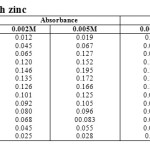 |
Table-1 Gliclazide with zinc Click here to View table |
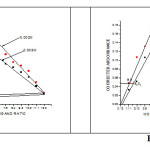 |
Fig.1a, Fig.1b Click here to View figure |
Synthesis of Complexes
The chemicals used in this synthesis were all of analar grade Hi-media. A weighed quantity of Gliclazide (2 mol) (supplied by Zim laboratory Nagpur) was dissolved separately in minimum quantity of 90% ethanol. The Zinc chloride solution was prepared by dissolving (1 mol) separately in the same solvent. Ligand solution was added slowly with stirring into the metallic salt solution at room temperature; maintain the pH between 6.0 to 6.5 by adding dilute NaOH solution. On refluxing the mixture for 3 hours and on cooling the complexes separated out. Which were filtered off, washed well with ethanol and finally dried in vacuum and weighed.
RESULT AND DISCUSSION
Physico-chemical Characterstics of “Glicazide-zinc complex
Molecular formula (C15H21N3O3S)2 Zn, Mol.wt: 443.92; Colour:white;6 Yield:53.16%; m.p86:1oC, –ΔF: 16.00; LogK: 10.75; Anal. Calcd (%) for (C15H21N3O3S)2 Zn, : C,51.03; H,6.03; N,11.64; S,9.01; Zn,6.0; Found (%): C,50.83; H, 5.63; N,11.86; S,9.03; Zn,8.74.
Infra-red Spectra Studies
The IR spectra (Fig 2) of ligand and isolated complex was recorded within the range 4000-400 cm-1. Assignments of the infrared spectral bands are based on literature IR spectrum shows important bands due to n(M-O) 400-600 cm-1, n(Ar-S) 700-800 cm-1, n(-S-N) 1085±20 cm-1, n(SO2-N) 1120±20 cm-1, n(C-N) 1210±20 cm-1, n(S=O) 1340±20 cm-1, n(C=O) 1710 cm-1( present only in pure drug and variation in complex),1600±20 cm-1vs, (C-H Stretch)2800-2900cm-1 ,v(Ar-H) 3150±20 cm-1 ,n(NH-stretch) 3274±20 cm-1.The proposed structure (I) for the isolated complex is also supported by IR absorption , C.N.Rao23. , Bellamy 24,and Weissberger25.
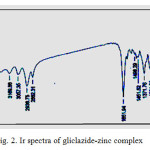 |
Fig. 2. Ir spectra of gliclazide-zinc complex Click here to View figure |
X-RAY DIFFRACTION STUDIES
X-ray diffraction studies also confirm the complex and formation due to new bonds 26-33. The number of peaks in gliclazide are 22 while (GLZ)2Zn are 11 (Fig-3) . Thus indicating the something new formation i.e complex formed is a well kit one. All the reflections present are new ones and the patterns are fairly strong. On comparing the pattern obtained with available literature. It is evident that its pattern is not in good agreement with available information and thus confirms the formation of totally new complexes. The X-ray pattern have been indexed by using computer software(FPSUIT 2.0V) and applying interactive trial and error method keeping in mind the characteristics of the various symmetry system, till a good fit was obtained between the observed and the calculated Sin2θ value. The unit cell parameters were calculated from the indexed data, from cell data and crystal lattice parameters of Zn(II) indicates complex attributed to orthorhombic crystal system. The particle size is 7.28 nm which is calculated from x-ray line broadening using the Scherrer formula Dhkl =κλ/βhkl cosθ, where D is the particle diameter in ångstroms, κ is a coefficient and is equal to 0.89 here, β is the half-maximum line width, and λ is the wavelength of x-rays, porosity is 6.84 calculated by formula
![]()
and volume of the unit cell is 14065 is calculated by Volume(Å), = abc where a, b and c are lattice parameters . Density = weight / volume is found 0.050 g/cm3. Space group is Pmmm and α=90°, β=90°, γ =90°, crystal system- orthorhombic. Cullity34(1978), Duval35 Bragg and Bragg36 , Guinier37(1952), Henry et al38, (1951), Kidwai39(2011).
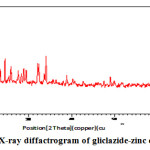 |
Fig.3: X-ray diffactrogram of gliclazide-zinc complex Click here to View figure |
Hypoglycemic Studies
Pharmacotherapy includes the treatment of the sick with drugs and therefore is of prime importance in practice of medicine. It is fundamental to the health-economy of the people. A compound or a complex which is to be recommended as a drug of utility must be capable of easy absorption and excretion. It is also essential that neither the absence itself nor the metabolic products thereof should exercise toxicity or any adverse side effect to the patient.
- Where necessary such tests should be carried out on animals as rats, rabbits and dogs. When a substance has given satisfactory results for the aforesaid animals then only it may be tried on monkeys and men.
- In present study we analyze the hypoglycemic activity of pure drug and its complexes with zinc on albino rats.
Animal care and handling
The anti-diabetic activity was carried out on Wistar albino rats of 4 months of both sexes, weighing between 140 to 200 gm. They were provided from Sapience Bio-analytical Research Laboratory, Bhopal, (M.P.). The animals were acclimatized to the standard laboratory conditions in cross ventilated animal house at temperature 25±2°C relative humidity 44 –56% and light and dark cycles of 12:12 hours, fed with standard pallet diet and water ad libitum during experiment. The experiment was approved by the institutional ethics committee and as per CPCSEA guidelines (approval no. 1413/PO/a/11/CPCSEA).
Chemicals
Alloxan monohydrate was purchased from Central Drug House (P) LTD. Gliclazide was provided as gift sample by Zim laboratories, Nagpur. All other chemicals used for this study were of analytical grade.
Induction of diabetes by alloxan 41-43
The diabetes was induced by a single intraperitoenal injection of a freshly prepared solution of Alloxan monohydrate (120 mg/kg b.w.). Hyperglycemia was confirmed on the third day of Alloxan-injection. Rats with moderate diabetes having hyperglycemia (with blood glucose above150 mg/dl) were taken for the experiment.
Experimental Design
In the experiment, a total of 24 rats were used. The rats were divided into 5 groups.
Comprising of 6 animals in each group as follows:-
Group I: Normal control rats received 1ml/100gm of 0.5% CMC (carboxy methyl cellulose) using an intragastric tube for 4 days.
Group II: Negative control rats received Alloxan 120g/kg, i.p. for inducing diabetes.
Group III: Rats received gliclazide (2mg/kg, p.o.) for 4 days and alloxan 120g/kg, i.p. on 1st day.
Group IV Rats received gliclazide-zinc complex, (2mg/kg, p.o.) once daily for 4 days and Alloxan 120g/kg, i.p. on 1st day.
Sample collection
At the end of study(7th day), blood samples were collected through tail vein and blood glucose levels were estimated using an electronic glucometer and result is given in table 2, 3.
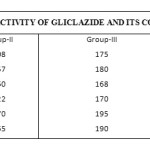 |
Table.2. HYPOGLYCEMIC ACTIVITY OF GLICLAZIDE AND ITS COMPLEXES AT 3th DAY(mg/dl) Click here to View table |
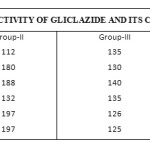 |
Table.3. HYPOGLYCEMIC ACTIVITY OF GLICLAZIDE AND ITS COMPLEXES AT 7th DAY(mg/dl) Click here to View table |
DISCUSSION
For supporting the proposed structure of gliclazide-zinc complex , initially Job,s method of continuous variation as modified by Turner and Anderson was conducted which indicate 2:1 ligand:metal ratio of the complex , moreover stability constant and free energy change was also calculated .Analytical data agrees to the molecular formula (C15H20N3O3S)2Zn , (L2M) .
For determining the proposed structure on the basis of stoichiometry and analysis of the complexes. Advance spectroscopic methods like IR was conducted which suggest the coordination of metal atom with enolic oxygen of the carbonyl group on one side and oxygen of the sulphonyl group from the other side. A detailed study of X-Ray also supports the complexes formation and the various values like particle size , porosity , volume of unit cell , density as well as crystal system was evaluated and discussed .Moreover looking to the higher electronegativity of oxygen as compared to nitrogen and to enolization is strongly supported.
Zinc complex of gliclazide was evaluated for their hypoglycemic effect on experimental rats using alloxan induced diabetes model. The effect of zinc complex of gliclazide on blood glucose level at 3rd and 7th day of alloxan induced diabetes in rats shown in table-3, 4 respectively. So from table we can conclude that zinc complex of gliclazide have more hypoglycemic activity as compared to parent drug. These interesting observations on metal-complex of oral sulphonylureas used as antidiabetic agents for lowering blood sugar concentration may likely substantiate the use of these complexes after extensive clinical studies.
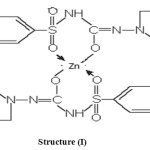 |
Structure (I) Click here to View figure |
ACKNOWLEDGEMENT
The author is thankful to the principal of Saifia Science College, Bhopal India, Principal of Crescent College of Technology, Bhopal for providing all necessary facilities and IIT, Bombay ,P.U Chandigarh, India for providing IR spectra and X-Ray data.
Reference
- 1.Underwood E J., Trace element in human and animal nutrition 3rd ed, Academic press, New York N.Y., P-57 (1971).
- Sadilot S M,. Pathak R B, J.Diabet.Assoc.India 32(4) (1992).
- Bloomgarden , American Diabetes Association Consensus Statement on pharmacologic treatment, Diabetes Care,22 SIS117,(1999)
- Sanger E O L .Thompson, Ibid.,53,535,366,(1951)
- Yoshinaga I , Yamamotto Y., Endocrinologie(Gen),50,3.(1966a)
- I. Yoshinaga, Y. Yamamotto, J.Osaka 1,3.1966b
- S.A. Iqbal. Sibi Jose and Ishaq Zaafarany, Orient,J.Chem. 28(1),613-618, (2012)
- Sharma S.,Iqbal,S.A., and Budhani P.,Orient.J.Chem.26(1) 287-300, (2010)
- Iqbal S.A and Zaafarny I.,Orient.J.Chem,28, 613-618, (2012)
- George Jacob, Syed Aftab Iqbal and E.H. El- Mossalamy, Asian J. Chem. 23(2) 573-576, (2011)
- AL-Janabi A.S and Ahmed S A ,Orient.J.Chem.27(4) 1563-1571, (2011)
- Singh S ,.Singh K.K and Singh J.P ,Orient.J.Chem.27(3) 1233-1237, (2011)
- Khan M.R and Sahdev,Orient.J.Chem.27(2) 649-653, (2011)
- Shankar K and.Nazeera A.B,Orient.J.Chem.,27(2) 655-660, (2011)
- Salih N, Salimon F and Yousif Emad., Orient J. Chem, 27(2) 373-383, (2011).
- Mervat M., El-Enany, Salwa, E.M., El-Meligie, Nadia A., Abdou and Hala, B, El-Nasean ,Orient J. Chem; 26 (4) 1265-1270, (2010)
- Saxena R, Sahdev and. Ahmed S . Orient J. Chem, 26(4) 1507-1511, (2010)
- Azimi M and .Ahmad. , Orient J. Chem. 27 (2) 673-677, (2011)
- P.Job,Ann.Clim,113:10 (1928)
- Terner S.E and. Anderson R.C,J Am.Chem.Soc.,912:71(1949)
- Irving H,Rossotti H.S.:J.Chem.Soc. 2904, (1954)
- Irvin H,Rossotti H.S.:J.Chem.Soc. 1176, (1955)
- Rao C.N.R, Chemical Applications of Infra-red spectroscopy, Academic press NY.(1963)
- Bellamy L J. The Infra-red spectra of complex molecules.Matheun and Co.Ltd. London (1964)
- Weissberger A, Chem. Application of spectroscopy”, Vol. XI Inter Science Publ. New York. (1956)
- Pandeya S.N. ,. Sriram, D ,Nath G. and E.De. Clereq, Arzneim-forsch/Drug Res. 50, (2000) 55
- F Khan and R Bilgainya, Indian . J.chem.50A, 55-59, (2011)
- Kidwai, M ,Sapra P. ,. Mishra P,. Saxena R.K and. Singh M, Bioorg. Med. Chem. 9, (2011)217
- Reddy H.K. ,.Seshaiah D.P and.Reddy A.V,Orient.J.Chem.27(3) 1125-1131, (2011)
- Henry N.F.M , Lipson H and Wooster W.A. , Interpretation of X-ray diffraction photograph.Acta Cryst.5 859, (1952)
- Chohan, Zahid , M. Praveen. and A. Ghaffer., Synth. React. Inorg. Met. Org. Chem 28(1998),
- Bal krishan and Iqbal,S.A., Orient.J.Chem.,28(4) 1883-1888, (2012)
- Altermatt D,. and, Brown I.D,. Acta Cryst B41 244-247, (1985),
- I.D, Brown,., The Chemical bond in inorganic chemistry, The bond valence model IUCR monographs on crystallography, 12, Oxford University Press, www.ccp14.ac.uk/ccp/web-mirrors/idbrown(2002),
- Cullity B.D.Elements of X-ray diffraction 2nd Ed.disonWesley,publishing company, Inc. (1978)
- Duval CInorganic thermogravimetric analysis, Elsevier publishing Co., London, New York (1983)
- Bragg, W.L. and Bragg, W.H.The crystalline state A general survey, London, (1950)
- Guiner, A.X-ray crystallographic technology, I Liger and Walts-London (1952)
- Henry, N.F.M., Lipson, H. and Wooster, W.A.The interpretation of X-ray diffraction photographs. The Mac. Millan Company, London (1951)
- Mukherjee Pulok K Quality control of herbal drugs, an approach to evaluation of botanicals, Business horizons Pharmaceutical publishers, New Delhi, India.(2008)
- Jyoti M, Vihas TV, Ravikumar A, Sarita G Glucose lowering effect of aqueous extract of Enicostemma Littorale Blume in diabetes: a possible mechanism of action. J. Ethnopharm. 81: 317-20
- Ashcroft F W., Gribble F M, Journal of Diabetes and its complications: 14, (2000) 192-196

This work is licensed under a Creative Commons Attribution 4.0 International License.









